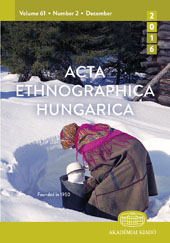Beekeeping in Csongrád
Beekeeping in Csongrád
Author(s): Judit SzűcsSubject(s): Agriculture, Local History / Microhistory, Social history, Middle Ages, Modern Age
Published by: Akadémiai Kiadó
Keywords: beekeeping; honey; skep; hive; melliferous flowers;
Summary/Abstract: According to the evidence of linguistics, the Hungarians brought the knowledge of beekeeping with them to the Carpathian Basin. Beekeeping and the consumption of honey must have been a common practice in Csongrád (historically the county seat in the early Middle Ages), a settlement surrounded by water, as records show that in 1138 the people here were required to pay a tax in márc (mead). In Turkish times, mid-16th-century defters (taxation lists) provide evidence of beekeeping during that period. After the Turks were driven out of Hungary, a record dating from 1731 shows that as part of his economic organising activity the Hungarian landowner Sándor Károlyi wanted to make beekeeping a taxable activity. Notitia, an 18th-century description by Mátyás Bél (minister of religion, teacher, historian), and the survey ordered in the time of Joseph II record the endowments for beekeeping (extensive natural stretches of water and melliferous wildflowers) as well as the man-made conditions (cultivated melliferous plants such as tobacco, grapevines, fruit trees). 19th-century sources also confirm the existence of local beekeeping. Material collected orally in 2004 shows that folk and peasant beekeeping was practised at several places in the area in the late 19th and the 20th centuries. In addition to establishing the locations, in a few places the researchers also obtained a description of the place occupied by beekeeping in the peasant economy. The oral data record the traces of beekeeping in live trees and of harvesting honey in the wild, the process of transition from skep to box hive in the late 19th and early 20th centuries, the various types of hives, the method of making mead and the occasions on which honey was eaten.
Journal: Acta Ethnographica Hungarica
- Issue Year: 55/2010
- Issue No: 1
- Page Range: 157-170
- Page Count: 14
- Language: English
- Content File-PDF

